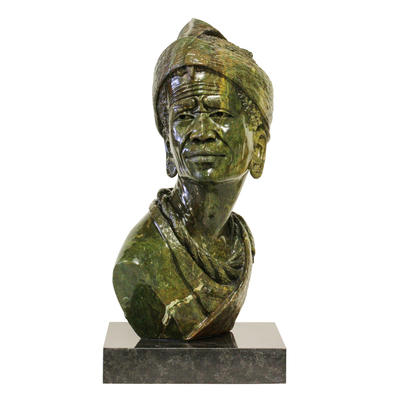James Tandi
Classical Master Sculptor - 3/16/1956 - 9/6/2020
James' works continue to amaze collectors and critics alike with his masterful sculptures of Africa’s native people and wildlife. Under the tutelage of his older brother, renowned sculptor Nicholas Tandi, James quickly showed a natural talent for sculpting. James worked in the classical method using hammer and chisel to beautifully capture the native African people and indigenous wildlife of southern Africa in verdite.* ...More...
Each sculpture began with James visiting the verdite mine where he selected his own stone. Unlike marble, which can be cut to accommodate the subject of the sculpture, verdite comes from the mine in a variety of shapes which will invariably dictate what will be created. James refers to this process as “revealing the spirit which is within the stone.” After painstakingly removing layer upon layer of stone and carving each minute detail, the sculpture is wet-sanded and fired to a high temperature before applying stone wax. Each piece is then hand polished to a beautiful luster. James participated in many international one-man and group exhibitions. His list of collectors has grown steadily over the years and his works can be found in both African and North American museums.
* Verdite, also known as the “green stone of Africa” is highly sought after by artists. Only the more experienced sculptor will dare to sculpt from this hard stone. Verdite rates between a 7.0 – 9.0 on the universally used Mohs hardness scale (hardness depends on the amount of Corundum industrial ruby inclusions in the particular piece of stone). Verdite’s color is unique in that it boasts an emerald-looking quality with beautiful brown, blue and green striations. Verdite is fast becoming rare and is difficult to find....Less...
James' works continue to amaze collectors and critics alike with his masterful sculptures of Africa’s native people and wildlife. Under the tutelage of his older brother, renowned sculptor Nicholas Tandi, James quickly showed a natural talent for sculpting. James worked in the classical method using hammer and chisel to beautifully capture the native African people and indigenous wildlife of southern Africa in verdite.* ...More...
Each sculpture began with James visiting the verdite mine where he selected his own stone. Unlike marble, which can be cut to accommodate the subject of the sculpture, verdite comes from the mine in a variety of shapes which will invariably dictate what will be created. James refers to this process as “revealing the spirit which is within the stone.” After painstakingly removing layer upon layer of stone and carving each minute detail, the sculpture is wet-sanded and fired to a high temperature before applying stone wax. Each piece is then hand polished to a beautiful luster. James participated in many international one-man and group exhibitions. His list of collectors has grown steadily over the years and his works can be found in both African and North American museums.
* Verdite, also known as the “green stone of Africa” is highly sought after by artists. Only the more experienced sculptor will dare to sculpt from this hard stone. Verdite rates between a 7.0 – 9.0 on the universally used Mohs hardness scale (hardness depends on the amount of Corundum industrial ruby inclusions in the particular piece of stone). Verdite’s color is unique in that it boasts an emerald-looking quality with beautiful brown, blue and green striations. Verdite is fast becoming rare and is difficult to find....Less...













